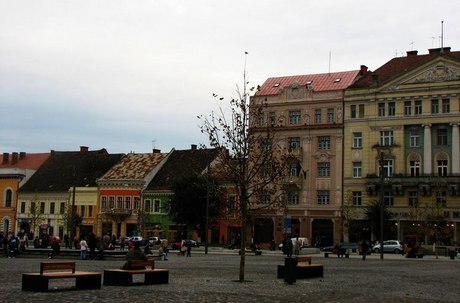Union Square
Piaţa Unirii (Romanian for Union Square) is the largest and most important plaza in the Romanian city of Cluj-Napoca. The square is one of the largest in Romania, with dimensions of 220 m by 160 m. The centre of the city spreads out from this square. The St. Michael's Church, with the highest church tower in Romania (80m), is the second largest Gothic-style church in Romania. The church was constructed in two phases. The first from 1316 to 1390 and the second from 1410 to 1487. Also, the statue of King of Hungary Matthias Corvinus is located here. Statue of Matei Corvin was unveiled in 1902 in the Cluj central square, becoming in time one of the distinctive signs of the city
The monument is composed of an equestrian statue of King Matthew Corvin, and in the front of the statue there are placed 4 other statues: Paul The Chinese (leader of Timis) Blasiu Magyar (old leader of the mercenaries of Matei Corvin - the famous "Black Army"), Stephen Szapolyai (vice king of Hungary) and Stephen Bathory (hospodar in that time in Transylvania).
Matthias Corvinus (23 February 1443 – 6 April 1490), also called the Just in folk tales, was King of Hungary and Croatia from 1458, at the age of 14 until his death. After conducting several military campaigns he became also King of Bohemia, (1469–1490) and Duke of Austria. Matthias was born in Cluj-Napoca in a house now known as the Matthias Corvinus House. He was second son of John Hunyadi, a successful general of Wallachian (Romanian) origin in service of the Kingdom of Hungary, who had risen through the ranks of the nobility to become regent of Hungary. Matthias' mother was Erzsébet Szilágyi, from a Hungarian noble family. Matthias was 15 when he was elected King of Hungary: at this time the realm was environed by perils.
The Matthias Corvinus House (Romanian: Casa Matei, Hungarian: Mátyás király szülőháza) is one of the oldest buildings in Cluj-Napoca (Kolozsvár), Transylvania. It was built in the 15th century as a small guesthouse. During its history, the house served as a jail, hospital, and museum; it is now home to a visual arts institute.
The old town hall, the National Museum of Art, the Josika Palace, and the Rhédey palace can also be found here.
Apart from the medieval buildings, there are also Roman and Dacian ruins under the square, partially visible thanks to a glass screen in the plaza.
The Unirii Square was originally called Nagypiac in Hungarian (Piaţa Mare in Romanian), meaning "Big Market Square", as opposed to the Kispiac ("Little Market Square"), which is now the Museum Square.
Featuring baroque, gothic, Renaissance and neoclassical buildings, the square allows for quick access to St. Michael's Church and the Banffy Palace. Flanking the church on the south side is a 1902 equestrian statue of the 15-th century ruler, Matei Corvin. In the southwest corner of the square stands Hotel Continental, built in 1895 in an eclectic style combining Renaissance, classical and baroque elements. During World War II, the hotel served as the German military headquarters in Transylvania. Across the square, you can visit the Hintz House, which served as Cluj's first and longest-running pharmacy (1573-1949) and is now home to the Pharmacy Museum. This museum, exhibiting some 2,300 medical instruments, is located on the site of Cluj-Napoca's first pharmacy (1573).
The Cluj Point Zero, Union Square represents the center of Cluj Medieval city, grouped around the Church of St. Michael. The Square is the largest square (about 220 meters to 160 meters) among the old squares in center and southeastern of Europe. There are larger squares, but they were formed much later.
In the middle of the square are the St. Michael Church and Statue of Matthias Corvinus. Sides are containing the famous buildings: on the east side is the Banffy Palace, which now houses the Art Museum and 2 buildings built in the mirror.




